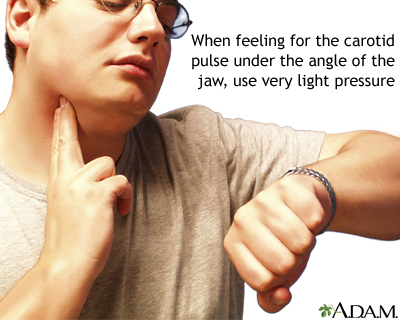Pulse - bounding
Bounding pulseA bounding pulse is a strong throbbing felt over one of the arteries in the body. It is due to a forceful heartbeat.
-
Causes
A bounding pulse and rapid heart rate may both occur in the following conditions or events:
- Abnormal or rapid heart rhythms
- Anemia
- Anxiety
- Long-term (chronic) kidney disease
- Fever
- Heart failure
- Heart valve problem called aortic regurgitation
- Heavy exercise
- Overactive thyroid (hyperthyroidism)
- Pregnancy, because of increased fluid and blood in the body
- Use of caffeine or other stimulants
-
When to Contact a Medical Professional
Contact your health care provider if the intensity or rate of your pulse increases suddenly and does not go away. This is very important when:
- You have other symptoms along with increased pulse, such as chest pain, shortness of breath, feeling faint, or loss of consciousness.
- The change in your pulse does not go away when you rest for a few minutes.
- You already have been diagnosed with a heart problem.
-
What to Expect at Your Office Visit
Your provider will do a physical exam that includes checking your temperature, pulse, rate of breathing, and blood pressure. Your heart and circulation will also be checked.
Your provider will ask questions such as:
- Is this the first time you have felt a bounding pulse?
- Did it develop suddenly or gradually? Is it always present, or does it come and go?
- Does it only happen along with other symptoms, such as palpitations? What other symptoms do you have?
- Does it get better if you rest?
- Are you pregnant?
- Have you had a fever?
- Have you been very anxious or stressed?
- Do you have other heart problems, such as heart valve disease, high blood pressure, or congestive heart failure?
- Do you have kidney disease?
- Do you consume stimulants such as caffeine or cold medicine or drugs such as amphetamines or cocaine?
The following diagnostic tests may be performed:
- Blood studies (CBC or blood count), basic metabolic panel
- Chest x-ray
- Electrocardiogram (ECG)
- Echocardiogram
References
Fang JC, O'Gara PT. History and physical examination: an evidence-based approach. In: Libby P, Bonow RO, Mann DL, Tomaselli GF, Bhatt DL, Solomon SD, eds. Braunwald's Heart Disease: A Textbook of Cardiovascular Medicine. 12th ed. Philadelphia, PA: Elsevier; 2022:chap 13.
Japp AG, Din JN, Robson JMJ. The cardiovascular system. In: Dover AR, Innes JA, Fairhurst K, eds. Macleod's Clinical Examination. 15th ed. Philadelphia, PA: Elsevier; 2024:chap 4.
McGrath JL, Bachmann DJ. Vital signs measurement. In: Roberts JR, Custalow CB, Thomsen TW, eds. Roberts and Hedges' Clinical Procedures in Emergency Medicine and Acute Care. 7th ed. Philadelphia, PA: Elsevier; 2019:chap 1.







